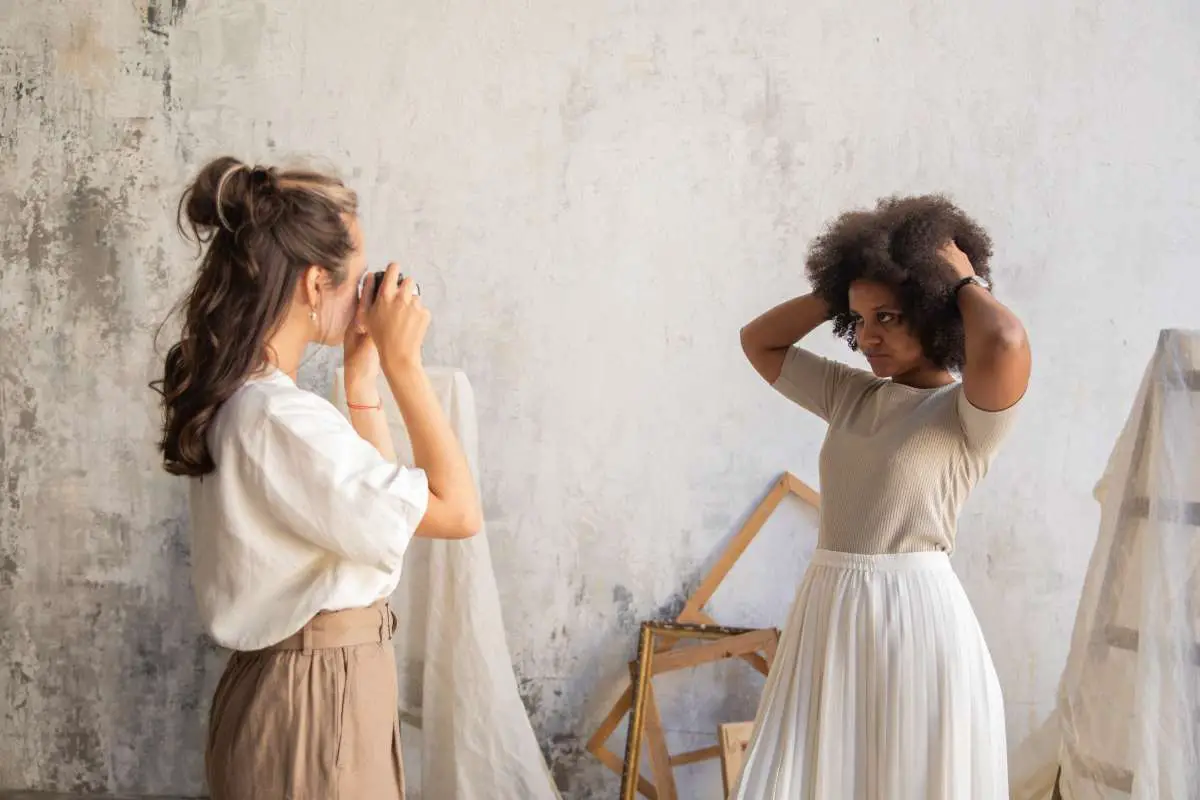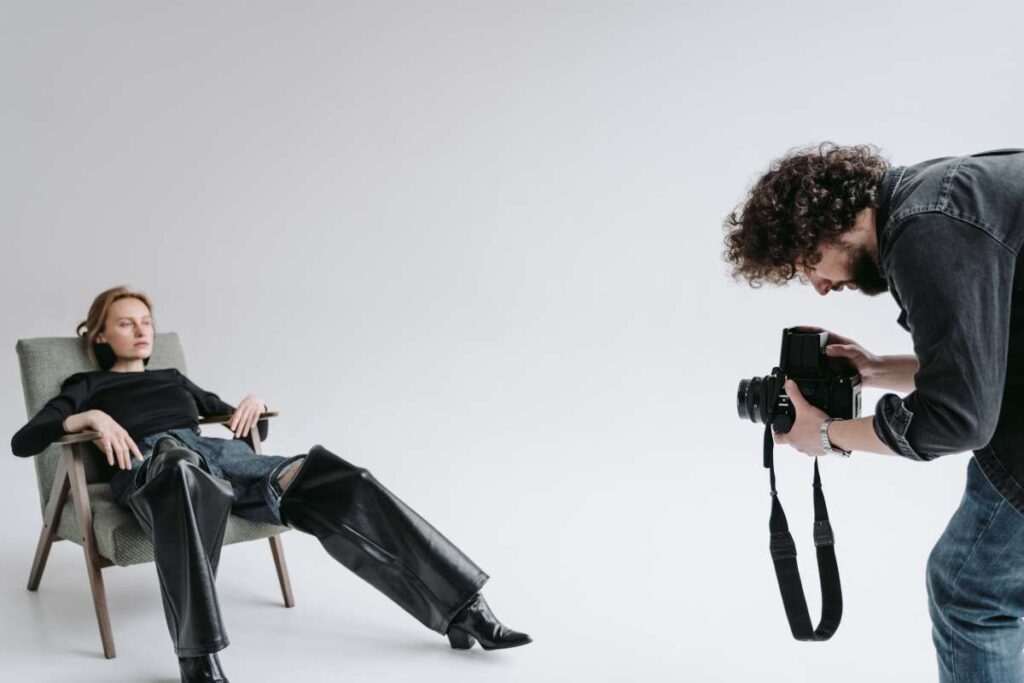Portrait photography isn’t just about taking a picture; it’s about capturing the essence of a person in a single frame. A successful portrait combines technical expertise with an artistic touch, balancing elements like lighting, composition, and pose to create an image that tells a story.
Below is a detailed guide on essential techniques and tips to elevate your portrait photography.
Let’s get straight to the point
Portrait photography involves capturing the subject's essence with technical skill and artistic vision. Key tips include preparing the subject for natural expressions, mastering camera settings, selecting the right lens, and understanding the exposure triangle (shutter speed, aperture, ISO) for balanced light.
Framing, background selection, and unique angles add character while experimenting with focus and motion can evoke emotion. Good lighting, natural interactions, and a cohesive colour scheme bring depth to the portrait.
Lastly, focus on the eyes for a compelling shot. These techniques help develop a unique style that resonates with viewers, turning each portrait into a timeless story.
1. Preparing the Subject for the Portrait

Getting your subject comfortable is crucial for capturing a natural expression. Follow these steps to help your subject relax:
- Engage in light conversation: Chatting can ease nerves, especially if the subject is self-conscious.
- Encourage input on poses or expressions: Allow them to suggest comfortable poses.
- Pay attention to wardrobe: Suggest neutral or dark clothing to keep focus on the face. Avoid clothes with distracting details like uneven buttons or collars.
- Check the subject’s appearance: Make sure there’s no lint or stray hair that could distract from the final image.
Ensuring your subject is at ease gives you a better chance of capturing an authentic expression.
2. Mastering Camera Functions
To succeed in portrait photography, understanding your camera’s features is essential. Here’s how to get started:
- Familiarise yourself with manual settings: Learning to control exposure, focus, and white balance will give you greater creative freedom.
- Use a DSLR or mirrorless camera for flexibility with settings and higher-resolution images.
- Experiment with settings: Practice with different settings to see how each affects the final image.
Mastery these functions allows you to capture your subject precisely as you envision.
3. Choosing the Right Lens for Portrait Photography
Selecting the best lens depends on the look you want:
- 50mm or 85mm lenses: Great for headshots and close-ups, these focal lengths reduce distortion while keeping the subject in focus.
- Wide-angle lenses: Ideal for environmental portraits that show more background, adding context to the image.
- Longer focal lengths: Help create a blurred background (bokeh) that makes the subject stand out.
Choose your lens based on the environment and the desired depth of field to highlight your subject effectively.
4. Understanding Shutter Speed, Aperture, and ISO
The exposure triangle—shutter speed, aperture, and ISO—is the backbone of photography. Here’s how each element contributes to portraits:
- Shutter Speed: Use a fast shutter speed to avoid blur, especially in outdoor settings or with active subjects.
- Aperture: A wider aperture (like f/1.8 or f/2.8) will blur the background, focusing attention on the subject.
- ISO: Lower ISO levels (e.g., 100-400) provide clearer images, especially in bright light.
Experimenting with these settings will give you control over light, depth, and clarity.
5. Framing and Composition
Framing directs attention to your subject. Use these framing techniques:
- Frame with natural elements: Use doorways or windows to frame your subject.
- Close-ups for emphasis: Fill the frame with the subject’s face for powerful, detail-rich shots.
- Off-centre placement: Following the rule of thirds creates a balanced, visually pleasing composition.
Framing techniques add depth and focus to your images, making your subject stand out.
6. Capturing Different Expressions and Poses

A natural expression adds authenticity to your portraits. To achieve this:
- Guide your subject: Offer simple directions like “Relax your shoulders” or “Tilt your head slightly.”
- Encourage different emotions: Ask the subject to express a range of emotions, from joy to thoughtfulness, and capture the shift in their expressions.
- Refer to sample poses: Keep a portfolio of successful poses to inspire your subject and offer ideas.
These methods will help you capture genuine emotions, giving life to the portrait.
7. Background Selection for Portrait Photography
Choosing a background that complements the subject is essential:
- Plain backgrounds: Plain backgrounds keep focus on the subject and reduce distractions.
- Environmental backgrounds: Use relevant settings (like an artist in their studio) to add context to the story.
- Blurred backgrounds: Adjust the aperture to create a soft, out-of-focus background highlighting the subject.
A thoughtfully chosen background enhances the image without taking away from the subject.
8. Exploring Angles and Perspectives
Breaking away from conventional angles can add character to your portraits:
- Experiment with high or low angles: Capture a unique perspective by changing your position.
- Try tilted frames: Tilting the camera slightly can add a playful feel, but use this sparingly to avoid accidental-looking shots.
- Wide-angle for wider backgrounds: Creatively show off a unique environment by using a wide-angle lens.
Altering perspectives brings energy and freshness to your portraits.
9. Playing with Focus for Artistic Shots
Blurred or out-of-focus shots can evoke emotion. Here’s how to use it effectively:
- Partial blur: Focus on a specific point, like the eyes, and let other areas blur slightly.
- Full-frame blur: Create a dream-like effect by focusing well before or behind the subject.
- Manual focus with a wide aperture: Allows for selective focus, drawing the viewer’s eye to key areas.
Out-of-focus shots add a touch of mystery and artistry to portraits, setting your work apart.
10. Introducing Motion for Dynamic Portraits
Adding motion to a portrait can create an engaging and lively effect:
- Ask your subject to move: Walking or turning can create natural, dynamic images.
- Use a slower shutter speed to blur moving elements, like flowing fabric or hair.
- Hold the camera steady and let your subject move: This technique captures natural movement, giving the image a sense of vitality.
Incorporating motion makes the portrait feel alive, adding energy to the composition.
11. Lighting Tips for Better Portraits
Light is critical in defining the mood of your portrait:
- Natural light for a soft glow: Cloudy days provide diffused light, perfect for portraits.
- Golden hour lighting: The warm, low light of early morning or late afternoon adds a natural radiance.
- Reflectors for indoor shoots soften shadows and even lighting across the subject’s face.
Mastering lighting techniques can dramatically enhance your portraits, bringing depth and warmth to the image.
12. Choosing Flattering Poses
A well-considered pose can greatly impact the portrait’s success:
- Seated poses for stability: Helps subjects feel grounded, especially if uncomfortable.
- Shoulder angles: Suggest a slight turn away from the camera for a natural, flattering look.
- Incorporate props: Items like flowers or hats add interest and can help relax the subject.
A good pose creates harmony between the subject, setting, and mood.
13. Encourage Natural Interactions
Candid shots often produce the best results. Here’s how to achieve them:
- Prompt natural reactions: Encourage your subject to laugh, speak, or move naturally.
- Distance yourself with a zoom lens: This helps the subject feel less observed and more comfortable.
- Capture in-between moments: Sometimes, the best shots happen between posed moments.
Allowing the subjects to interact freely can reveal their personality and make the portrait genuine.
14. Establish a Colour Scheme
Colours can create a cohesive look and add emotional resonance to your portraits:
- Choose complementary colours: Harmonise the background and attire to enhance the portrait.
- Warm tones for family portraits: Tones like green or beige create a welcoming atmosphere.
- Use bold colours for artistic effects: Darker tones like navy or charcoal work well for professional shots.
Crafting a colour scheme helps unify the image and enhances the subject’s appearance.
15. Focusing on the Eyes
The eyes often tell the story. Making them the focal point is crucial:
- Use autofocus points on your camera to lock in on the eyes.
- Position catchlights by placing the subject near natural light or using a reflector. This adds sparkle and depth.
- Keep focus steady while recomposing to ensure the eyes remain sharp.
Well-focused eyes bring intensity to the image, connecting the viewer to the subject.
Conclusion
Portrait photography blends technical skill and creative vision to capture the personality and story of the subject. By carefully considering elements like lighting, focus, pose, and background, you can create natural and compelling portraits. Practise these techniques regularly and adapt them to different subjects to develop a unique, recognisable style.
Remember, great portraits come from a photographer’s ability to connect with the subject and to adjust lighting, environment, and settings to create an image that resonates with viewers. With time and experience, you’ll be able to tell a story with each portrait, capturing the emotion and essence of your subject in a timeless and captivating way.
FAQs About Portrait Photography
The salaries of Portrait Photographers range from A$15,281 to A$262,949 , with a median salary of A$47730 . The middle 57% of Portrait Photographers makes between A$47735 and A$119421, with the top 86% making $262,949.
Constructionist, Candid, Environmental, and Creative are the four primary schools of thought within the subgenre of portrait photography.
Portraits are artistic depictions of real people or animals, either in art or in death. The term "portraiture" is commonly used to characterise works of this art. A portrait is meant to be a lasting tribute to the person it depicts.
In a nutshell, you'll want a digital single-lens reflex dslr. It is dependable, strong, and upgradeable, with a wide variety of lenses available to accommodate any type of photography. Choose a digital single-dslr reflex camera with a 35mm format for your fashion photography project.
Indeed, expensive equipment will not magically transform you into a skilled photographer. There's no hiding the fact that a camera costing A$6,000 is miles ahead of one costing just A$600, or that a lens costing A$3,000 is miles ahead of one costing just A$300. Higher-quality image files are the primary benefit of using professional camera equipment.

